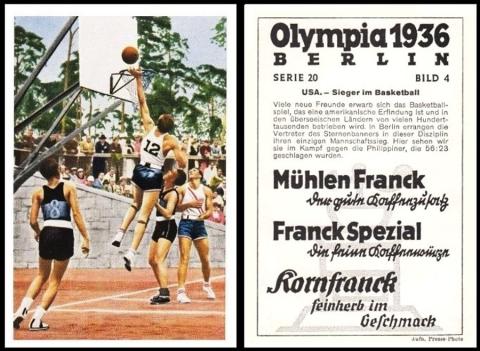
Here, to close out our week, we have a very unusual card, and maker.
Now a few people think that the name on the card, as we say it, is incorrect, and that it really stands for a Mr. Franck, who ground, or milled ("muhlen") the coffee that he sold.
I have had a very quick follow of that lead and this could well be the case, except that Mr. Franck seems to be Croatian, and, intriguingly, to be the first person that thought of turning chicory into a substitute for coffee. His company started in 1828 as Heinrich Franck Sohne G.m.b.H., and the website contains a pictorial archive. Only problem is that it does not mention a branch in Germany - but it does show an Austrian one, which opened in 1879. And it is quite possible that this is the one which issued these cards.
Now when the Olympic Games came to Berlin, several sets were issued, but these were mostly with tobacco products, it is scarcer to find trade cards.
Also this very card is important to our theme, because the 1936 Olympics was the first year that had basketball as a medal sport, though it had been a demonstration sport as early as 1904, in St. Louis, USA - and also at the London Olympics in 1924. All the players were men though - women did not compete in Olympic basketball until 1976.
The image on this card shows the American team, who took the record for the most number of points scored in a game, fifty-six, in their first round, against the Phillippines. In the final they faced off against Canada, winning 19-8. They were also cheered on by none other than James Naismith, who awarded the medals too.
We know who the man scoring the goal is as well - he is the captain, Joe Fortenberry, a keen college player, and sought after, because he was almost seven feet tall. Now he played for two teams immediately after leaving college, both of whom have pretty amazing names. First was the Ogden Boosters, out in Utah, and then the McPherson Oilers, in Kansas. This is where he was playing when he got the nod for the Olympics.
He got eight of those final Olympic medal winning points too, despite the game being almost called off due to quite appalling weather, and playing conditions, the rain causing the clay court to turn to a river of mud.
After the Olympics he returned to America, and played right up to America`s entry into the Second World War, at which point he joined up to the Army Air Corps. After the war he settled down, selling petrol. And he died in 1993, aged eighty-two.
And, as a parting shot, he is also said to be the first ever player to successfully "slam dunk" a ball more or less every time - some of the other claimants for that honour only getting theirs infrequently, by luck. For the non-basketball fans amongst our readers, this term means that you leap in the air and push the ball through the net with both your hands. But hopefully after this week you will be a bit of a basketball fan too, or at least a little more learned about its great past and thrilling future.
